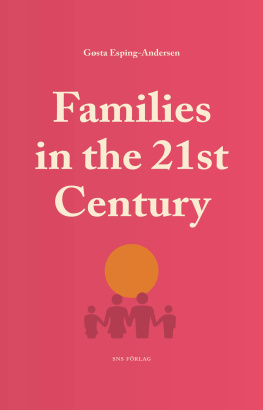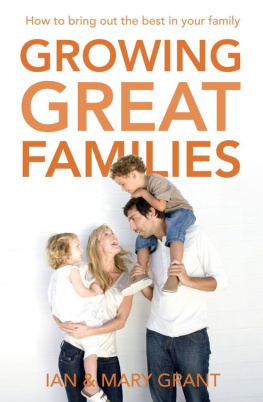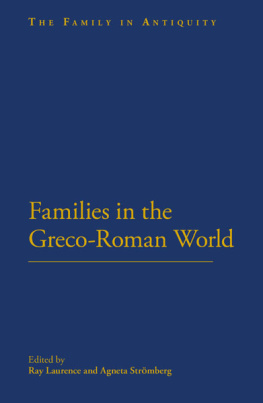Gsta Esping-Andersen
Families in the 21st Century
SNS FRLAG
SNS Frlag
Box 5629
SE114 86 Stockholm
Sweden
Phone: +46 8 507 025 00
www.sns.se
SNS, the Centre for Business and Policy Studies, is an independent non-partisan think tank with a mission to support evidence-based policy making. We do this through research and analysis, seminars, policy dialogues and professional training that engage leaders in government, business and civil society.
Families in the 21st Century
Gsta Esping-Andersen
2016 The author and SNS Frlag
Graphic design: Allan Seppa
ISBN 978-91-86949-87-7
E-boksproduktion: Axiell Media 2017
Foreword
In this book the author, Gsta Esping-Andersen, Professor of Sociology at the Universitat Pompeu Fabra, Barcelona, is taking a close look at the state of the family in the 21st century. Is the family eroding or can we identify a revival? How is gender equality developing and how does it affect the future of the family? Are families polarizing and, if so, what does this mean for childrens life chances? To answer these and other questions, Esping-Andersen presents a theoretical framework and analyses the available data to draw conclusions.
We hope this study can contribute to the contemporary debates on families, and also be of value for decision makers. The views expressed are, of course, those of the author. SNS as an organization does not take a position. The mission of SNS is to initiate and present research-based analyses of issues of importance for society.
Robert Erikson, Professor of Sociology at the Stockholm University, and Anna Sjgren, Associate Professor of Economics and a researcher at the Institute for Evaluation of Labour Market and Education Policy (IFAU), scrutinized the manuscript and provided the author with many valuable suggestions on how to improve the text, and also with ideas on how to delve further into the subject. Many thanks for that. Full responsibility still rests with the author alone.
Thanks also goes to Margarita Chudnovskaya, Ph.D. student of sociology at the Stockholm University, who assisted the author with Swedish data and data analyses.
The study is part of a research program on Investments in Equal Life Chances.The program has been made possible through funding from a reference group that is following the program. This group consists of Ersta Skndal University College, Famna, Folksam, Frskringskassan,Magelungen Utveckling, Ministry of Health and Social Affairs, Save the Children Sweden, Skandia, Stadsmissionens Skolstiftelse, Stockholm County Council, Swedish Association of Local Authorities and Regions, UNICEF Sweden, and the municipalities of Ale, Norrkping,Nynshamn, Tomelilla, and rebro. Chairman of the reference group is Per Nilsson, Vice-Chancellor of Ersta Skndal University College. Representatives from these entities have provided valuable suggestions and constructive criticism. Many thanks go to the members of the group. The reference group members and the entities they represent are in no way responsible for the analysis and the conclusions in the report. This responsibility, as mentioned, rests with the author alone.
Stockholm in September 2016
Stefan Sandstrm
Research Director, SNS
Executive Summary
Citing valid as well as questionable evidence, both the media and social scientists have for decades now portrayed the family as an endangered species: evermore citizens opt for singlehood or less binding kinds of partnerships (like living apart together), marriages appear evermore unstable, and people appear reluctant to have childrenwitness historically record low (and persistent) fertility rates across much of Europe.
In fact, the ever-less family scenario is very much what the two theoretical perspectives that dominate demographic research would predict. Gary Becker identifies the gains from conjugal specialization (one in paid employment, the other in domestic work) as the key advantage of partnering. It follows that the changing economic role of women will undermine this utility. The rival framework, known as the Second Demographic Transition thesis, predicts the very same outcome but emphasizes the role of postmodern values which promote individualism and self-realization.
in this book is dedicated to a close scrutiny of the evidence. With the most up-to-date evidence available, I examine long-run trends on all the key dimensions of family life. The dynamics I uncover seem to fit well with the family erosion thesis. But only up to a point. Since the mid-20th century, we do see a significant erosion of family formation on most dimensionsthe divorce boom, the surge in single person households, the rise of cohabitation, and sharply falling marriage and fertility rates. But the most up-to-date evidence ends up contradicting the less family thesis on almost all points. We discover that what citizens define as the ideal number of children has not changed at all since the postwar decades. And in a non-trivial number of countries,Scandinavia par excellence, the family is clearly recovering. We see a rise in marriages, partnerships are increasingly more stable, and fertility has risen and is now close to matching actual preferences. These new trends are especially visible in the two most recent decades.
Perhaps the single most revealing fact is that the return to more family is led by exactly the same social strata who, initially, spearheaded the less family scenarionamely the higher educated. In other words, it is now increasingly the lower social strata that epitomize the less family scenario.
What then explains this double rebound? Contrary to what Gary Becker predicted, the revolution of womens roles appears now to be compatible with strong families, stable partnerships, and also with childbearing. This leads us to ask: Are some countries (like Sweden) now turning their back on postmodern values? Or put differently, in 21st century Europe it is countries like Italy and Spain which display family erosion most blatantly.
What primarily motivated me to write this book was my conviction that the reigning theories had it all wrong. The key driver behind contemporary family dynamics is neither the end of the housewife, nor postmodern individualism. Instead, as I argue, the dynamics are driven by the revolution of womens roles.
In , I develop the central argument of my thesis, namely that the revolution will, in its early stages, indeed provoke fewer births, more singlehood, and less stable partnerships. The key turning point comes when both men and society at large adapt to womens new roles. It is when a new family equilibrium emerges, becomes stable, and enjoys broad normative acceptance that we will see stronger inclinations to partner and marry, more enduring relationships, and also a return to fertility levels that match citizens actual ideals.
is dedicated to empirical demonstrations of the validity of my u-shaped dynamics thesis, i.e. that the family is in fact resurgent. I show that societies with advanced levels of gender egalitarianism (the Scandinavian in particular) boast not only more marriages and births, but also more stable partnerships. In comparison, in nations such as Germany, Italy or Spain, where conventional gender norms remain salient, this is where the less family scenario is most marked. What is particularly clear is that the new gender egalitarian family equilibrium requires not only that social institutions (such as the labor market and the welfare state) become women friendly, but also that men adapt within partnershipsin particular by equally sharing domestic chores and child rearing.







